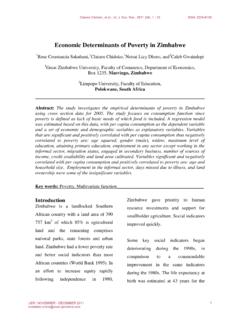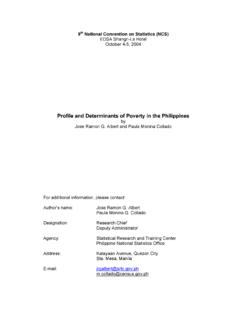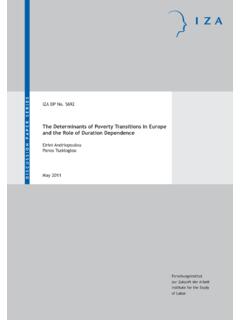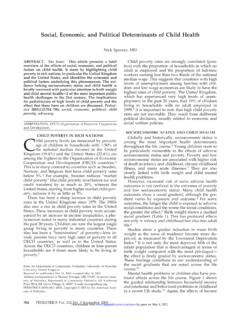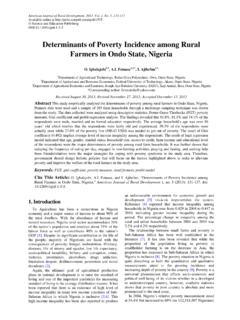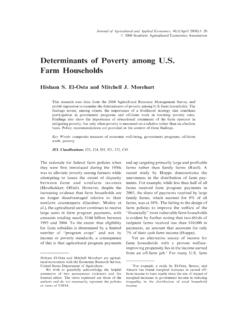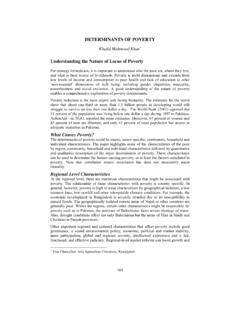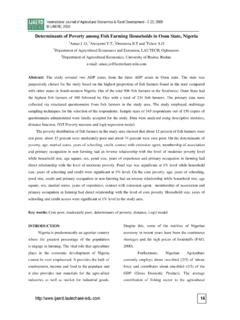Transcription of Chapter 8. Understanding the Determinants of Poverty
1 Poverty Manual, All, JH Revision of August 8, 2005 Page 124 of 218 Chapter 8. Understanding the Determinants of Poverty Summary A Poverty profile describes the pattern of Poverty , but is not principally concerned with explaining its causes. Yet a satisfactory explanation of why some people are poor is essential if we are to be able to tackle the roots of Poverty . Among the key causes, or at least correlates, of Poverty are: Regional-level characteristics: these include vulnerability to flooding or typhoons; remoteness; quality of governance; property rights and their enforcement. Community level characteristics: these include the availability of infrastructure (roads, water, electricity) and services (health, education), proximity to markets, and social relationships.
2 Household and individual characteristics: Among the most important are: Demographic: household side, age structure, dependency ratio, gender ofhead. Economic: employment status, hours worked, property owned. Social: health and nutritional status, education, shelter. Regression analysis is commonly undertaken to identify the effects of each of these characteristics on income (or expenditure) per capita. Care is needed to choose the independent variables carefully, to be sure that they are indeed exogenous. A number of more exotic techniques are now available for this purpose, including CART (classification and regression tree) models and multiple-adaptive regression splines (MARS models).
3 Regression techniques are good at identifying the immediate ( proximate ) causes of Poverty , but are less successful at finding the deep causes; they can show that a lack of education causes Poverty , but cannot so easily explain why some people lack education. Learning Objectives After completing the module on Poverty lines, you should be able to: 36. Identify the main immediate ( proximate ) causes of Poverty . 37. Classify the main causes of Poverty into characteristics related to the country or region, the community, and the household and individual. 38. Explain how regression techniques may be used to identify the proximate causes of Poverty and their relative importance.
4 39. Explain why researchers generally prefer to use regressions to explain income (or expenditure) per capita rather than whether an individual is poor or not. 40. Evaluate the assertion that the weakest part of Poverty analysis is the Understanding of its fundamental causes, and that this represents a missing middle that makes it difficult to define a successful anti- Poverty strategy. Poverty Manual, All, JH Revision of August 8, 2005 Page 125 of 218 What causes Poverty ? A Poverty profile describes the pattern of Poverty , but is not principally concerned with explaining its causes. Yet a satisfactory explanation of why some people are poor is essential if we are to be able to tackle the roots of Poverty .
5 This Chapter addresses the question of what causes Poverty . Poverty may be due to national, sector-specific, community, household or individual characteristics. This Chapter summarizes some of the characteristics of the poor by region, community, household and individual characteristics and then discusses how regression techniques can be used to determine the factors causing Poverty . Two cautions are in order. First, it can be difficult to separate causation from correlation. For instance, we know that poor people tend to have low levels of education; but are they poor because they have little education, or do they have little education because they are poor?
6 A statistical association alone is not enough to establish causality, and additional information is likely to be required. Second, most of the causes of Poverty that we identify in this Chapter are immediate (or proximate ) causes, but not necessarily deep causes. For instance, suppose that we can demonstrate that low levels of education do indeed increase the risk of Poverty . This is interesting, but now begs the question of why some people have low levels of education in the first place: Were the school fees too high? Was there no school nearby? Was the quality of the education abysmal?
7 Were their parents unsupportive, or even hostile to education? Was there a concern that an educated woman could not find a husband? The weakest part of Poverty analysis what Howard White calls the missing middle is developing a clear Understanding of the fundamental causes of Poverty . Such an Understanding is needed if one is to develop an effective strategy to combat Poverty . Since there is no reason to believe that the root causes of Poverty are the same everywhere, country-specific analysis is essential. Regional level characteristics At the regional level, there are numerous characteristics that might be associated with Poverty .
8 The relationship of these characteristics with Poverty is country-specific. In general, however, Poverty is high in areas characterized by geographical isolation, a low resource base, low rainfall, and other inhospitable climatic conditions. For example, many argue that economic development in Bangladesh is severely retarded due to its susceptibility to annual floods; and Nghe An province in north-central Poverty Manual, All, JH Revision of August 8, 2005 Page 126 of 218 Vietnam is poor in part because it is regularly hit by typhoons, which destroy a significant part of the accumulated stock of capital. In many parts of the world the remoteness of rural areas which lower the price farmers get for their goods and raise the price they pay for purchases, due to high transport costs is responsible for generating food insecurity among the poor.
9 Inadequate public services, weak communications and infrastructure, as well as underdeveloped markets are dominant features of life in rural Cambodia, as in many other parts of the world, and clearly contribute to Poverty . Other important regional and national characteristics that affect Poverty include good governance, a sound environmental policy, economic, political and market stability, mass participation, global and regional security, intellectual expression and a fair, functional, and effective judiciary. Regional-level market reforms can boost growth and help poor people, but it is important to note that they can also be a source of dislocation.
10 The effects of market reforms are complex, deeply linked to institutions and to political and social structures. The experience of transition, especially in countries of the former Soviet Union, vividly illustrates that market reforms in the absence of effective domestic institutions can fail to deliver growth and Poverty reduction. There is also a case for bringing vulnerability and its management to center stage. Participatory Poverty work underlines the importance of vulnerability to economic, health, and personal shocks. Inequality is also back on the agenda. New work shows the importance of gender, ethnic, and racial inequality as a dimension and a cause of Poverty .










